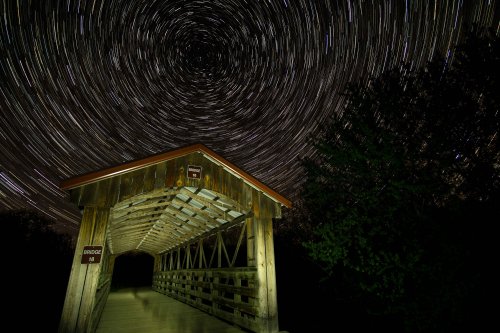"In the end we will conserve only what we love, we will love only what we understand, and we will understand only what we are taught."
Baba Dioum (born 1937), Senegalese forestry engineer
 |
| Bridge 14, Kickapoo Valley Reserve, Photo by Chad Berger |
The Kickapoo Valley Reserve, Wildcat Mountain State Park, and Mississippi Valley Conservancy are excited to announce they are working together to designate the 13,300 acres of KVR, Wildcat, and Tunnelville Cliffs as Wisconsin’s second International Dark Sky Park. The International Dark-Sky Association awards this distinction to "land possessing an exceptional or distinguished quality of starry nights and a nocturnal environment that is specifically protected for its scientific, natural, educational, cultural heritiage, and/or public enjoyment."
The application process requires a sky quality survey, lighting inventory and management plan, community partners, and education and outreach. They are assisted in this initiative by John Heasley, Marla Lind, and Scott Lind who hope to complete the process by 2022. Benefits of creating the Kickapoo Dark Sky Park include a healthier community and ecosystem, the financial benefits of tourism, the pride of being a world-leading community, and financial savings owing to reduced energy usage. But most important is preserving our heritage of starry skies for the enjoyment and awe of future generations.
Discovering the dark skies of the KVR for yourself is simple. Turn off your lights, give your eyes time to adapt to the dark, and look up. Print out a free copy of the monthly Sky Map to find your way around. A red light will help to preserve your night vision and binoculars will help you to see more colors and details. And don’t miss some of the special events of 2021. Full
Moons around June 24, July 23, August 22, September 20, October 20, November
19, December 18. Follow the lead of
Wisconsin naturalist Frances Hamerstrom and “Walk When the Moon is Full”
and discover the sights and sounds of KVR after dark.
Perseids
around August 12. Lie back on a chair or
blanket and watch this wonderful annual meteor shower.
Crescent
Moon and Venus. Look west after sunset
on June 12, July 11, August 11, September 9, October 9, November 7, December 6
to see a wonderful pairing of a slender Moon near brilliant Venus.
Lunar
Eclipse. Watch on November 19 between
midnight and 6 am as the Full Moon becomes red as it passes through the shadow
of the Earth.
Old 131 is especially good for twilight and
night hiking. The path is paved and it’s
easy to find your way. There are
trailheads at the Dam Tower and at CTH P. The Dam Tower, Visitor Center, and the large grassy field at Landing 14
are excellent spots to lie back and enjoy the stars and Moon and meteors. If you are staying the night, the views are
stellar at Campsites AA, A, C, I, J, K, L, and PP.
Unlike
other environmental problems such as groundwater contamination or global
warming, light pollution can be reduced “at the speed of light” with solutions that are relatively easy and
inexpensive. Good lighting reduces
energy consumption, respects the ecosystem and wildlife, safeguards human
health, promotes safety, and preserves the heritage of starry skies. The
Illuminating Engineering Society and International Dark-Skies Association have
come up with Five Principles for
Responsible Outdoor Lighting to enhance our quality of life:
Useful–All light should have a clear purpose. Before installing or
replacing a light, determine if light is needed. Consider how the use of light
will impact the area, including wildlife and the environment.
Targeted--Light should be directed only to where needed. Use
shielding and careful aiming to target the direction of the light beam so that
it points downward and does not spill beyond where it is needed.
Low
Light Levels--Light should be no brighter than
necessary.
Controlled--Light should be used only when it is useful. Use controls
such as timers or motion detectors to ensure that light is available when it is
needed, dimmed when possible, and turned off when not needed.
Color--Use warmer color lights where possible. Choose bulbs that
are marked 2700 Kelvin or lower to limit the amount of shorter wavelength
(blue-violet) light.
 |
| Campsite K at Night, Photo Courtesy of Friends of Kickapoo Valley Reserve |
Explore darksky.org for more resources to make it simple to preserve the night.
And visit lightpollutionmap.info to view your community from space. Choose enough light to
find your way at night, but not so much as to be visible from low Earth orbit!
John Heasley is an astronomy educator and stargazer who enjoys
connecting people with the cosmos. He volunteers with NASA/JPL as a Solar
System Ambassador , with the International Dark-Sky Association
as an Advocate, and the International Astronomical Union as a Dark
Sky Ambassador. For more information about stargazing in
southwest WI, like Driftless Stargazing
LLC on Facebook and find out whenever there's
something awesome happening in the skies.









